Submitted:
28 November 2023
Posted:
30 November 2023
You are already at the latest version
Abstract
Keywords:
1. Introduction
2. Materials and Methods
2.1. Study area
2.2. Data collection
2.3. Land-use optimization and allocation
2.3.1. Optimization objectives functions
2.3.2. Constraint equations
2.3.3. Land-use allocation
3. Results
3.1. Analysis of economic factors affecting agricultural land-use
3.1.1. Dominant agricultural land-use types
3.1.2. Socio-economic and environmental factors
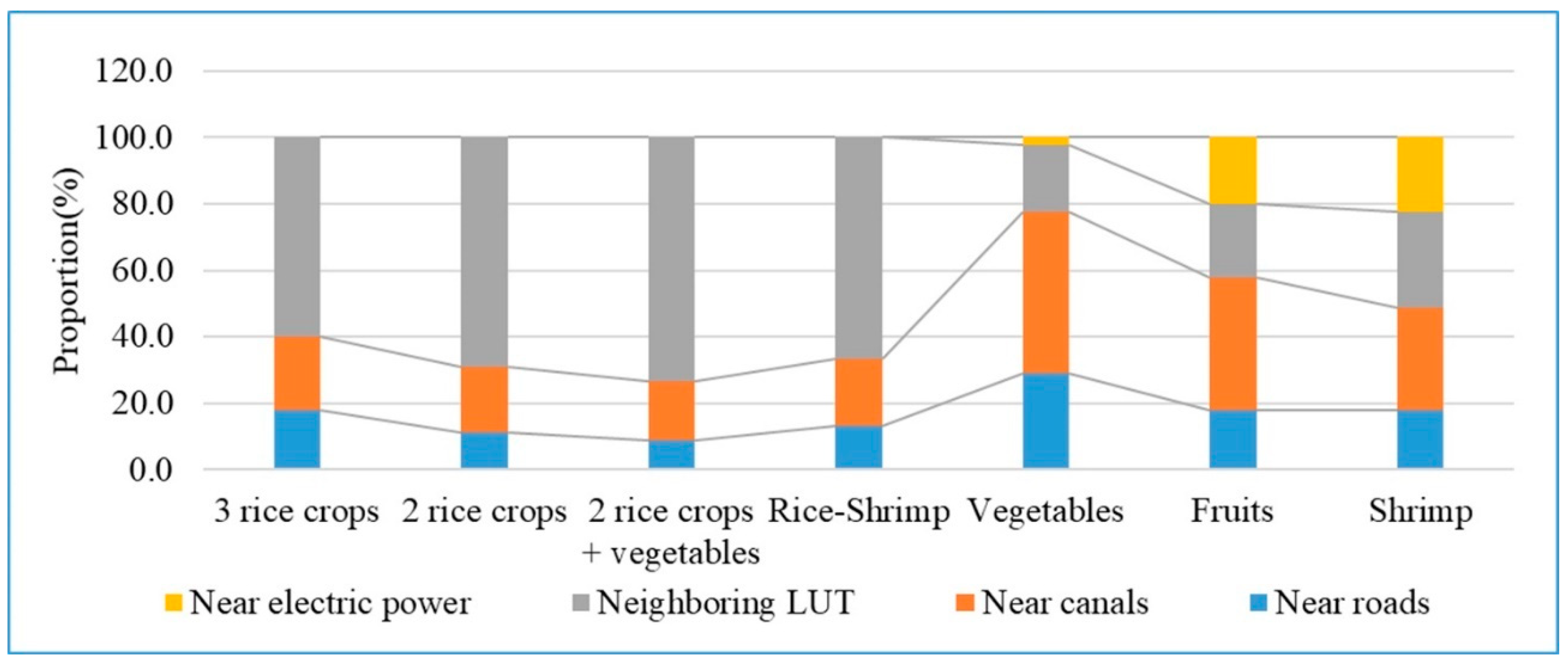
3.2. Application of integrated systems in Soc Trang province
3.2.1. Land evaluation
3.2.2. Configuring optimization scenarios
3.2.3. Exploring weights of the multi-objective land optimization module
3.2.4. Optimizing agricultural land-use area
3.2.5. Examining for the best options
4. Discussion
5. Conclusions
Supplementary Materials
Author Contributions
Funding
Data Availability Statement
Acknowledgments
Conflicts of Interest
References
- GSO Mekong Delta - Promoting the number one rice bowl advantage in the country 2021.
- Espagne, E.; Ngo-Duc, T.; Nguyen, M.-H.; Pannier, E.; Woillez, M.-N.; Drogoul, A.; Huynh, T.P.L.; Le, T.T.; Nguyen, T.T.H.; Nguyen, T.T.; et al. Climate Change in Viet Nam, Impacts and Adaptation : A COP26 Assessment Report of the GEMMES Viet Nam Project; Agence Française de Développement, 2021.
- Anh, D.L.T.; Anh, N.T.; Chandio, A.A. Climate Change and Its Impacts on Vietnam Agriculture: A Macroeconomic Perspective. Ecol. Inform. 2023, 74, 101960. [CrossRef]
- Wassmann, R.; Hien, N.X.; Hoanh, C.T.; Tuong, T.P. Sea Level Rise Affecting the Vietnamese Mekong Delta: Water Elevation in the Flood Season and Implications for Rice Production. Clim. Change 2004, 66, 89–107. [CrossRef]
- Loc, H.H.; Thi Hong Diep, N.; Can, N.T.; Irvine, K.N.; Shimizu, Y. Integrated Evaluation of Ecosystem Services in Prawn-Rice Rotational Crops, Vietnam. Ecosyst. Serv. 2017, 26, 377–387. [CrossRef]
- Bong, B.B.; Bo, N.V.; Son, N.H.; Tung, L.T.; Tu, T.Q.; Toan, T.Q.; Yen, B.T.; Trung, N.D.; Labios, R.V.; Sebastian, L.S. Adaptation Options for Rice-Based Cropping Systems in Climate Risk-Prone Provinces in the Mekong River Delta: An Assessment Report; Wageningen, the Netherlands: CGIAR Research Program on Climate Change, Agriculture and Food Security (CCAFS), 2018.
- Truong, Q.C.; Drogoul, A.; Gaudou, B.; Taillandier, P.; Huynh, N.Q.; Nguyen, T.H.; Minderhoud, P.; Nguyen Thi Thu, H.; Espagne, E. An Agent-Based Model for Land-Use Change Adaptation Strategies in the Context of Climate Change and Land Subsidence in the Mekong Delta. Sustainability 2023, 15, 5355. [CrossRef]
- Truong, Q.C.; Gaudou, B.; Van Danh, M.; Quang Huynh, N.; Drogoul, A.; Taillandier, P. A Land-Use Change Model to Study Climate Change Adaptation Strategies in the Mekong Delta. In Proceedings of the 2021 RIVF International Conference on Computing and Communication Technologies (RIVF); August 2021; pp. 1–6.
- Trang, N.T.; Tu, V.H.; Kopp, S.W. Trade-Offs between Economic and Environmental Efficiencies in Shrimp Farming: Implications for Sustainable Agricultural Restructuring in the Vietnamese Mekong Delta. Environ. Dev. Sustain. 2023. [CrossRef]
- FAO Guidelines for Land-Use Planning; FAO Development Series; 1993; ISBN 92-5-103282-3.
- FAO A Framework for Land Evaluation; Soil Resources, Management and Conservation Service, Ed.; FAO soils bulletin; 2. print.; FAO: Rome, 1981; ISBN 92-5-100111-1.
- Yamamura, K.; Tamura, N. Finding All Solutions of Separable Systems of Piecewise-Linear Equations Using Integer Programming. J. Comput. Appl. Math. 2012, 236, 2844–2852.
- Delphin, S.; Snyder, K.A.; Tanner, S.; Musálem, K.; Marsh, S.E.; Soto, J.R. Obstacles to the Development of Integrated Land-Use Planning in Developing Countries: The Case of Paraguay. Land 2022, 11, 1339. [CrossRef]
- Chuvieco, E. Integration of Linear Programming and GIS for Land-Use Modelling. Int. J. Geogr. Inf. Syst. 1993, 7, 71–83. [CrossRef]
- Mellaku, M.; Reynolds, T.; Woldeamanuel, T. Linear Programming-Based Cropland Allocation to Enhance Performance of Smallholder Crop Production: A Pilot Study in Abaro Kebele, Ethiopia. Resources 2018, 7, 76. [CrossRef]
- Aerts, J.C.J.H.; Eisinger, E.; Heuvelink, G.B.M.; Stewart, T.J. Using Linear Integer Programming for Multi-Site Land-Use Allocation. Geogr. Anal. 2003, 35, 148–169. [CrossRef]
- Phinyoyang, A.; Ongsomwang, S. Optimizing Land Use and Land Cover Allocation for Flood Mitigation Using Land Use Change and Hydrological Models with Goal Programming, Chaiyaphum, Thailand. Land 2021, 10, 1317. [CrossRef]
- Liao, G.; He, P.; Gao, X.; Lin, Z.; Huang, C.; Zhou, W.; Deng, O.; Xu, C.; Deng, L. Land Use Optimization of Rural Production–Living–Ecological Space at Different Scales Based on the BP–ANN and CLUE–S Models. Ecol. Indic. 2022, 137, 108710. [CrossRef]
- Vũ P.T.; Khương N.T.A.; Trí L.Q.; Huy V.T. Application of mathematical optimization method in agricultural land use - case study in Vi Thuy district, Hau Giang province. Can Tho Univ. J. Sci. 2016, 38–47. [CrossRef]
- Vũ P.T.; Lộc T.T.; Trí L.Q.; Huy V.T.; Trung N.H. Enhancing land use efficiency for income optimization of farm households in Tra Hat hamlet of Chau Thoi commune, Vinh Loi district, Bac Lieu province. Can Tho Univ. J. Sci. 2017, 54–63. [CrossRef]
- Verburg, P.H.; Overmars, K.P. Dynamic Simulation of Land-Use Change Trajectories with the Clue-S Model. In Modelling Land-Use Change: Progress and Applications; Koomen, E., Stillwell, J., Bakema, A., Scholten, H.J., Eds.; The GeoJournal Library; Springer Netherlands: Dordrecht, 2007; pp. 321–337 ISBN 978-1-4020-5648-2.
- Ligtenberg, D.V.P.H.V.A.K.B.A. An Agent-Based Approach to Model Land-Use Change at a Regional Scale. Landsc. Ecol. 2010, 25. [CrossRef]
- Wu, C.; Chen, B.; Huang, X.; Dennis Wei, Y.H. Effect of Land-Use Change and Optimization on the Ecosystem Service Values of Jiangsu Province, China. Ecol. Indic. 2020, 117, 106507. [CrossRef]
- Quang, T.C.; Diem, P.K.; Minh, V.Q.; Vu, P.T.; Vu, P.H.; Chinh, P.T. An Analysis of Land Use Options Using CLUMondo Model to Promote Agricultural Restructuring in the Mekong Delta’s Coastal Area in Vietnam. Agric. Sci. Dig. - Res. J. 2023, 43, 482–489. [CrossRef]
- Lambin, E.; Geist, H.J. Causes of Land-Use and Land-Cover Change Available online: http://www.eoearth.org/view/article/150964/ (accessed on 23 March 2015).
- Santiphop, T.; Shrestha, R.P.; Hazarika, M.K. An Analysis of Factors Affecting Agricultural Land Use Patterns and Livelihood Strategies of Farm Households in Kanchanaburi Province, Thailand. J. Land Use Sci. 2012, 7, 331–348. [CrossRef]
- Liu, J.; Xia, M. Influencing Factors Analysis and Optimization of Land Use Allocation: Combining MAS with MOPSO Procedure. Sustainability 2023, 15, 1401. [CrossRef]
- Loi L.T.; Tien L.T.M.; Vu P.T. Analysis of the factors affecting efficiency of agricultural land use patterns in the Ba Tri district, Ben Tre province. Can Tho Univ. J. Sci. 2016, 80–92. [CrossRef]
- Vu P.T.; Tri L.Q.; Dat N.T.; Huy V.T.; Nuong L.T.; Trung N.H. Using multi-criteria decision analysis in agricultural land uses in Bac Lieu province. Can Tho Univ. J. Sci. 2014, 106–115.
- Sofi, N.A.; Ahmed, A.; Ahmad, M.; Bhat, B.A. Decision Making in Agriculture: A Linear Programming Approach. 2015, 10.
- Tuan Anh, B.; Bong Dinh, N.; Tam Thi, D. Some Factors Which Influence management of Agricultural Land Use in Sontay Town, Hanoi City. J Sci Devel 2013, 11, 654–662.
- Tri L.Q.; Chi V.V.; Vu P.T.; Kiet N.H.; Binh N.T.S.; Guong V.T. Evaluating the changes of soil properties and land use at three coastal districts in Soc Trang province. Can Tho Univ. J. Sci. 2008, 59–68.
- Nghi N.Q.; Hien L.T.D. Market risk in agriculture of households in the Mekong Delta. Can Tho Univ. J. Sci. 2014, 33, 38–44.
- lp_solve Introduction to Lp_solve 5.5.2.5. Available online: http://web.mit.edu/lpsolve/doc/ (accessed on 4 June 2019).
- Taillandier, P.; Gaudou, B.; Grignard, A.; Huynh, Q.-N.; Marilleau, N.; Caillou, P.; Philippon, D.; Drogoul, A. Building, Composing and Experimenting Complex Spatial Models with the GAMA Platform. GeoInformatica 2019, 23, 299–322. [CrossRef]
- Enoguanbhor, E.C.; Gollnow, F.; Walker, B.B.; Nielsen, J.O.; Lakes, T. Key Challenges for Land Use Planning and Its Environmental Assessments in the Abuja City-Region, Nigeria. Land 2021, 10, 443. [CrossRef]
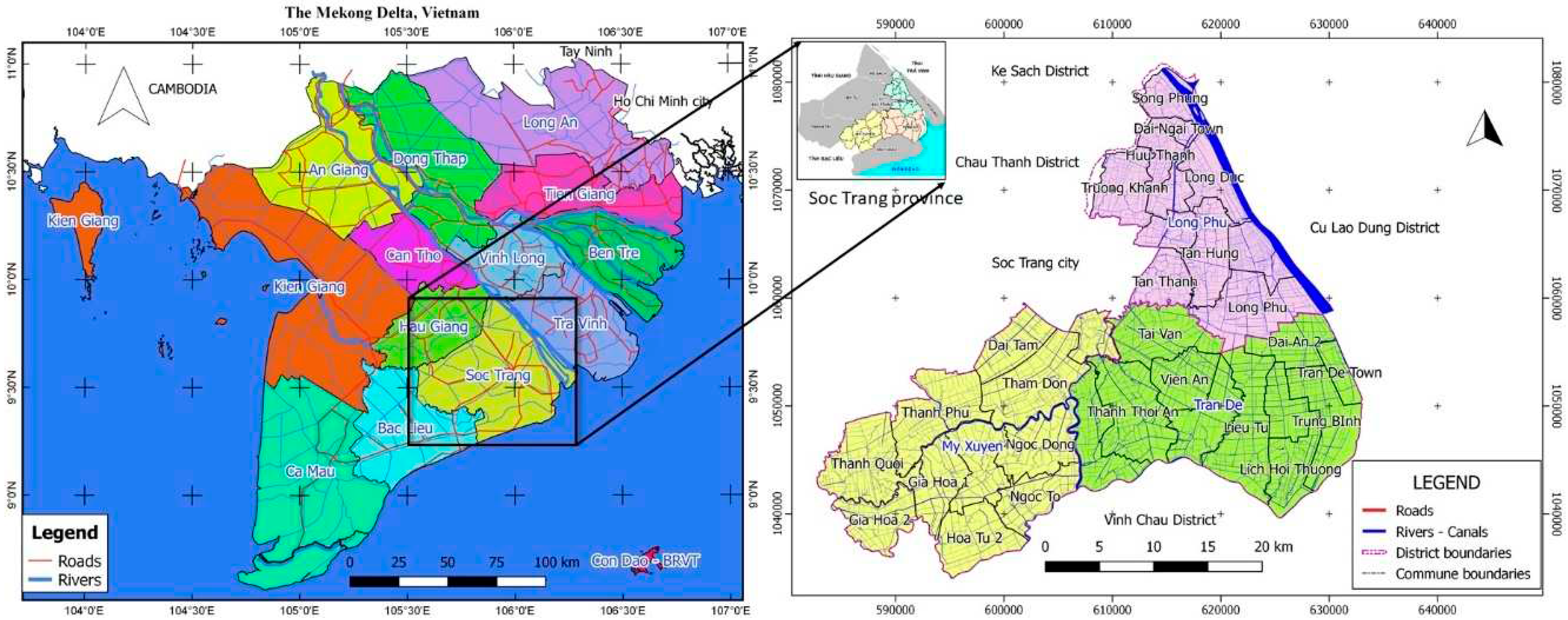
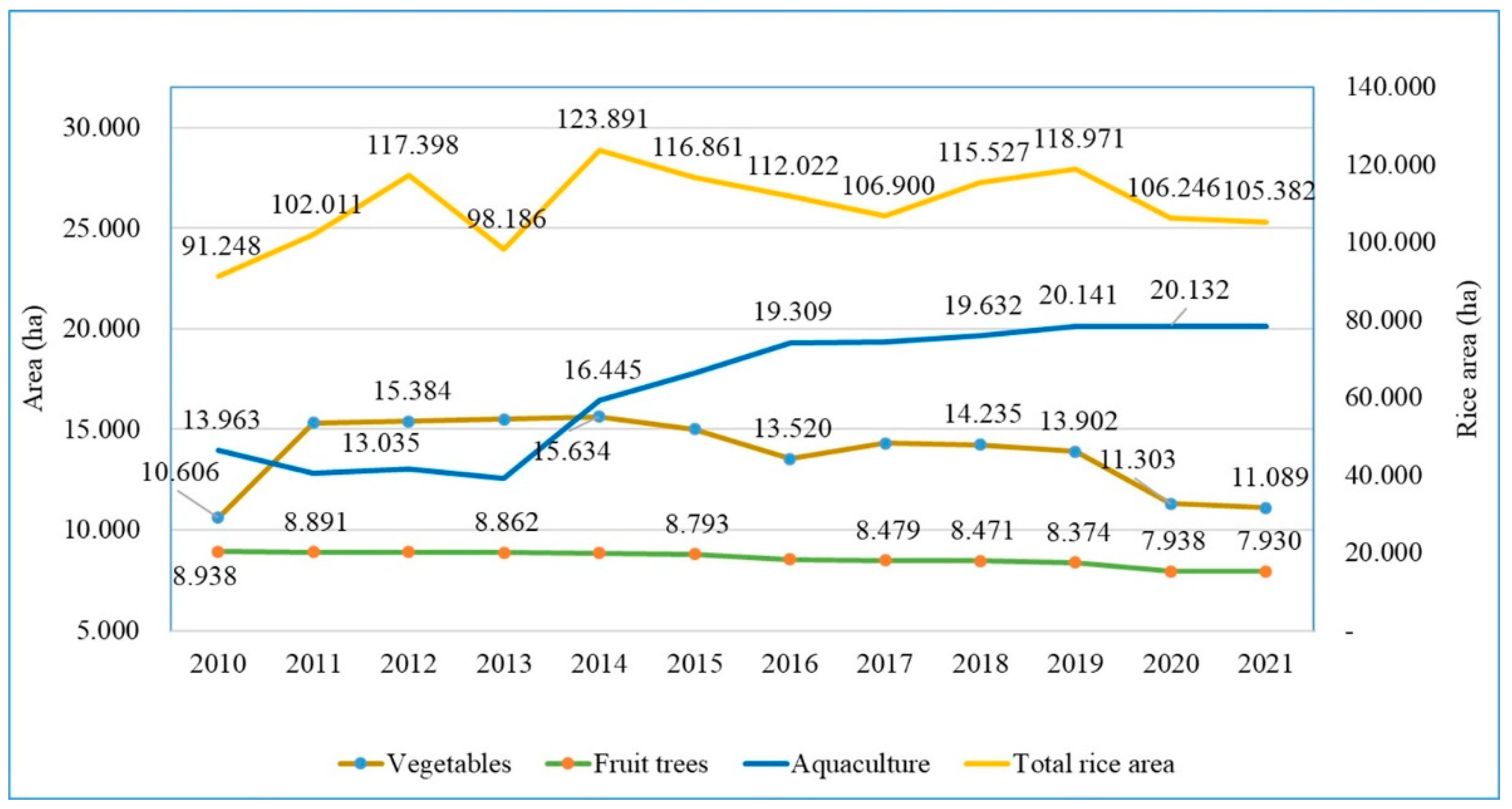
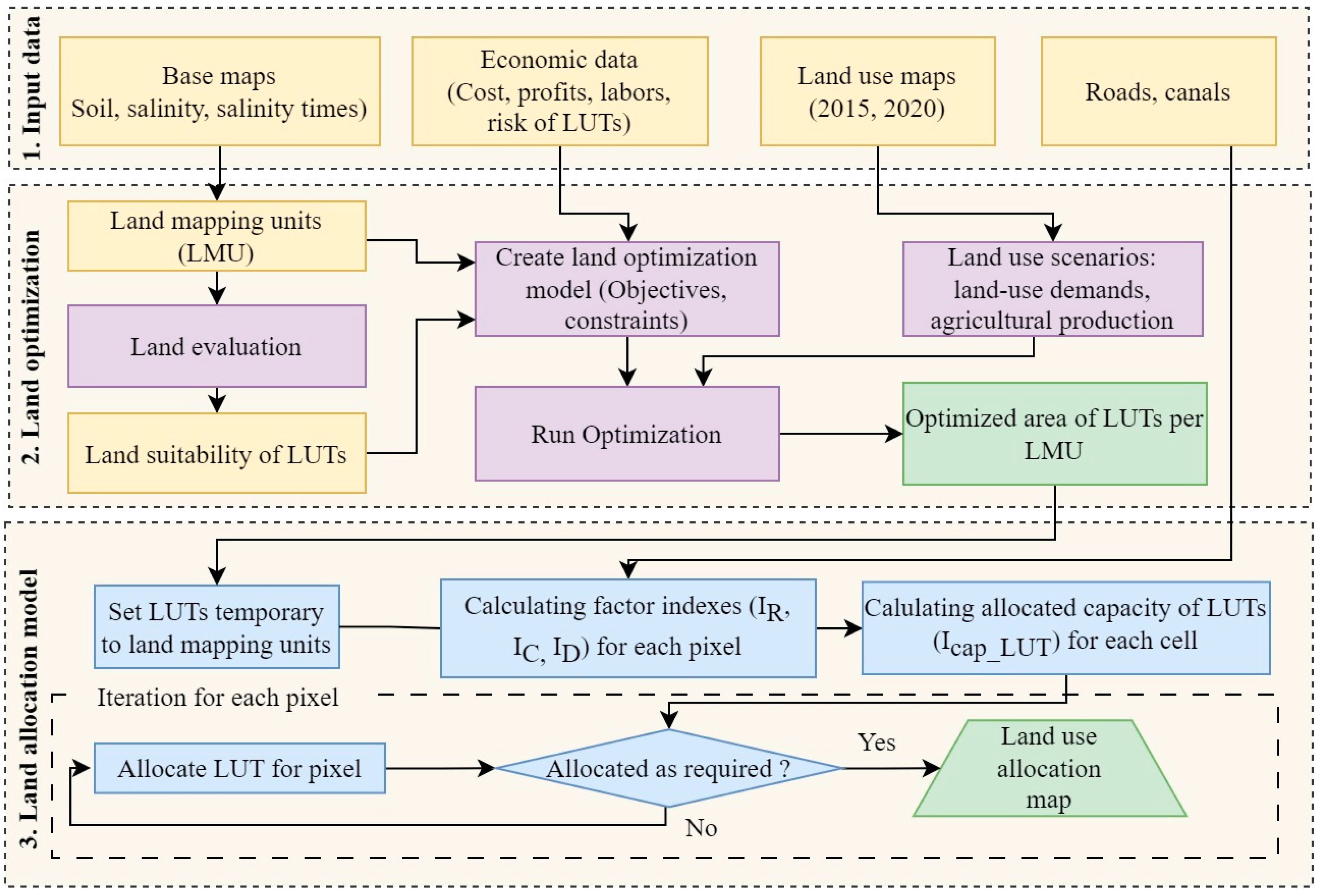
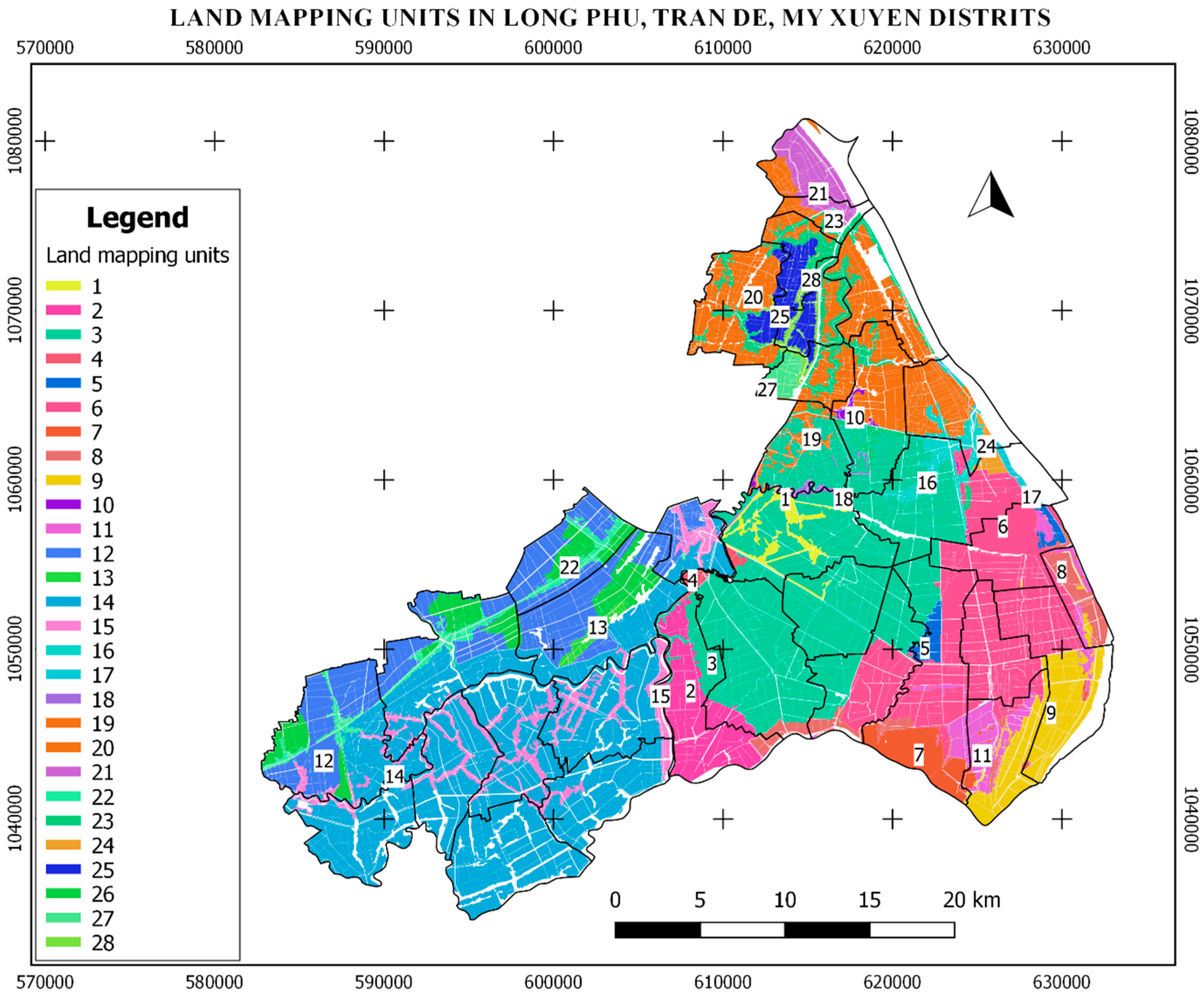
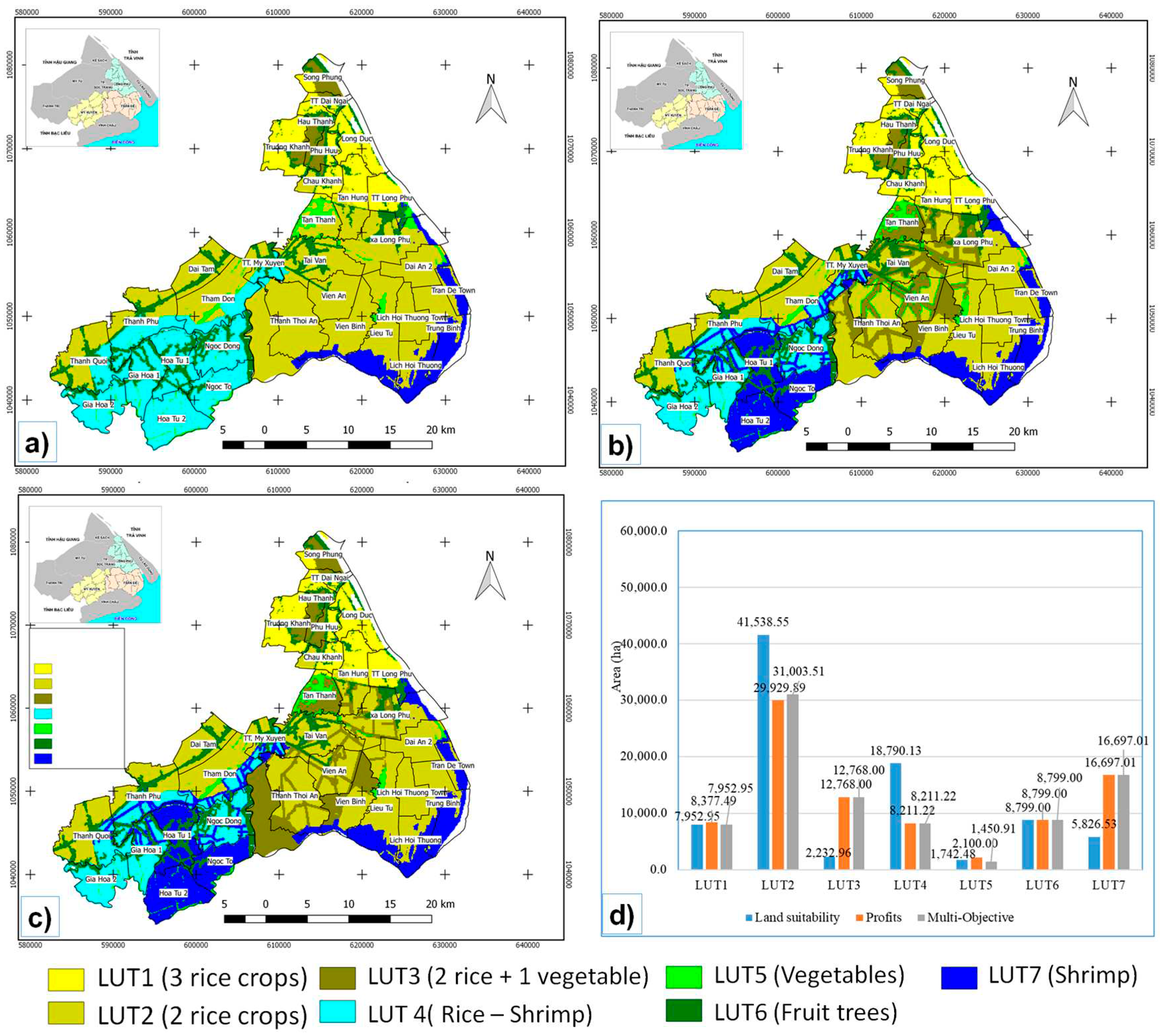
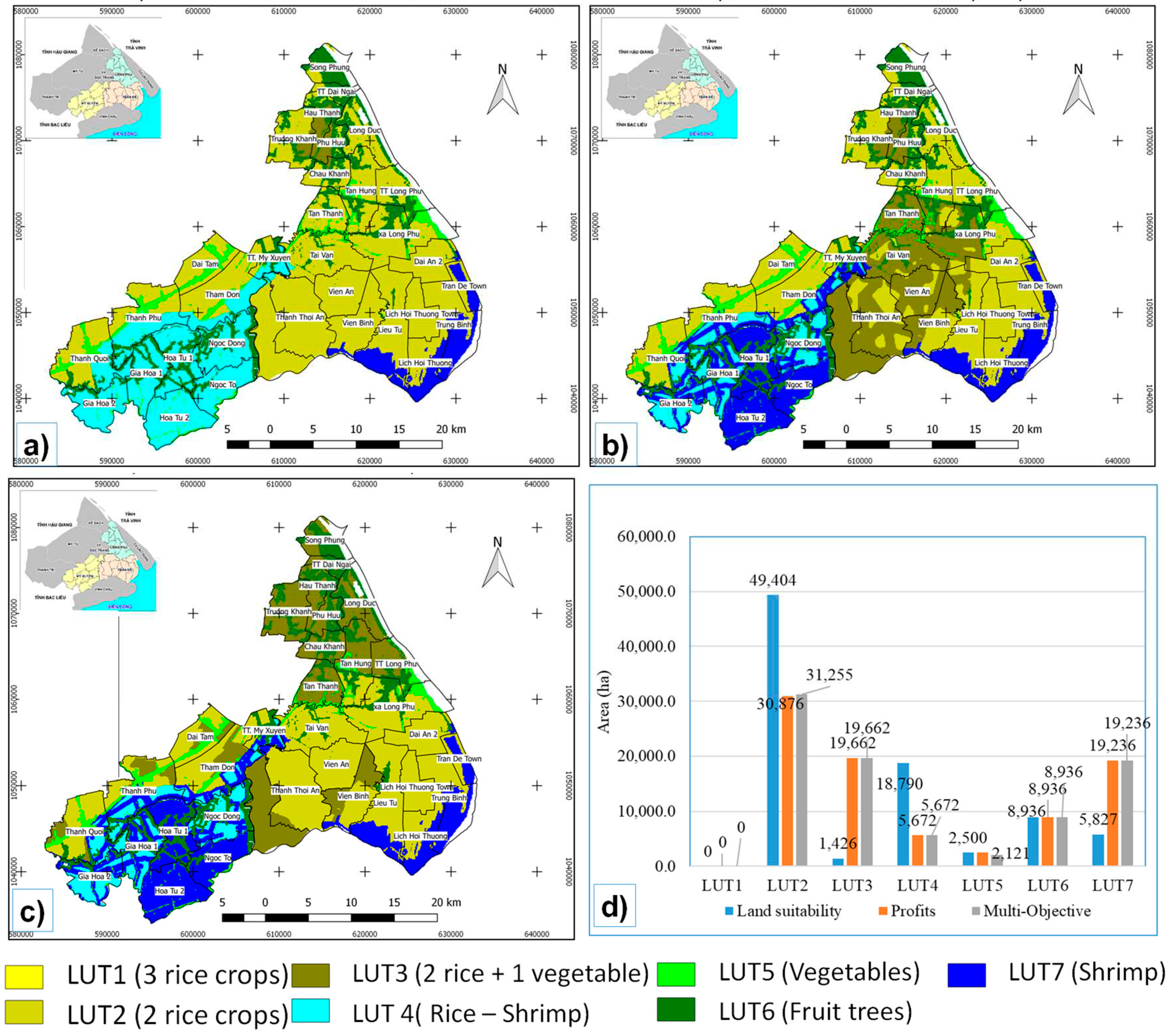
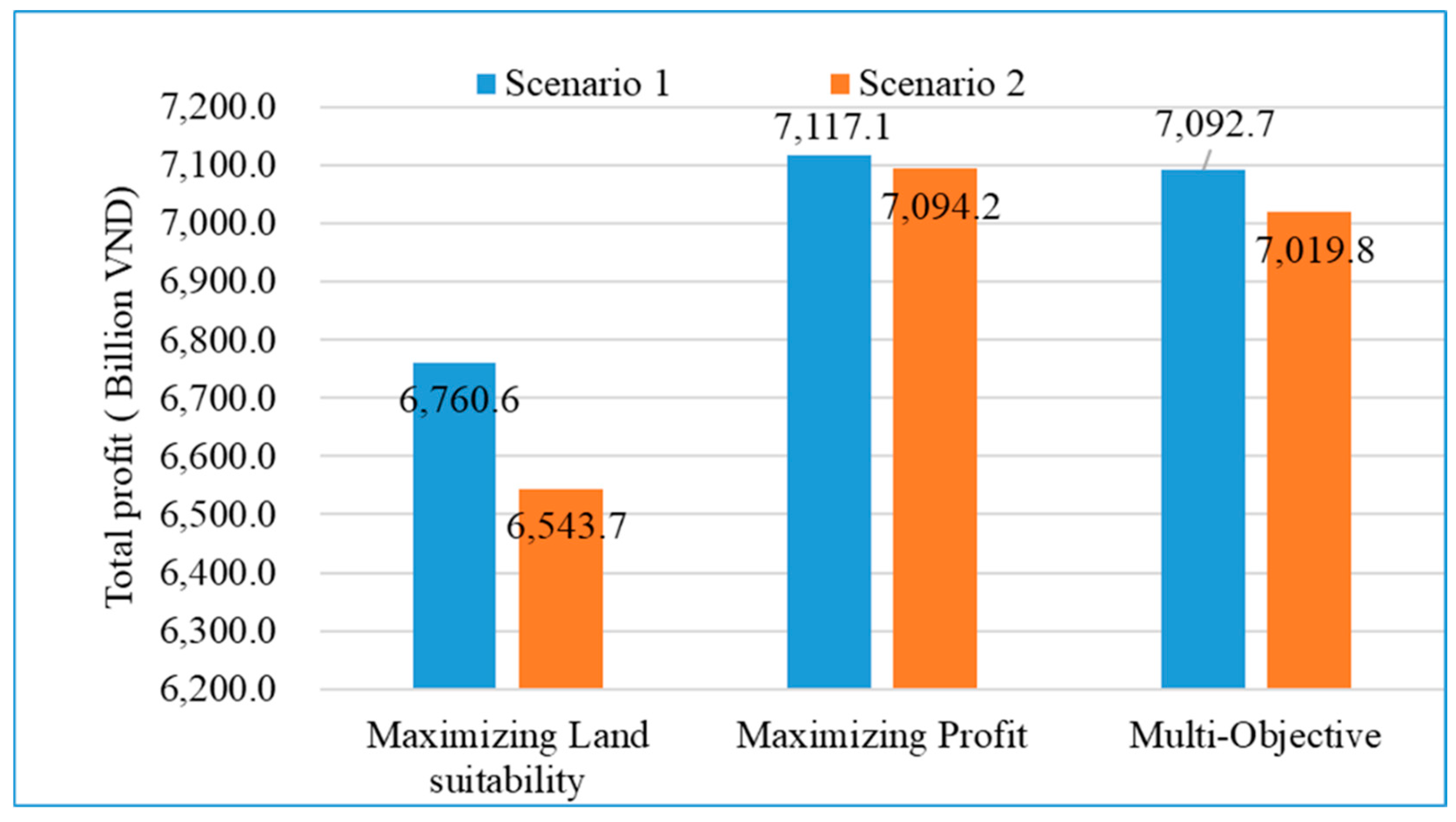
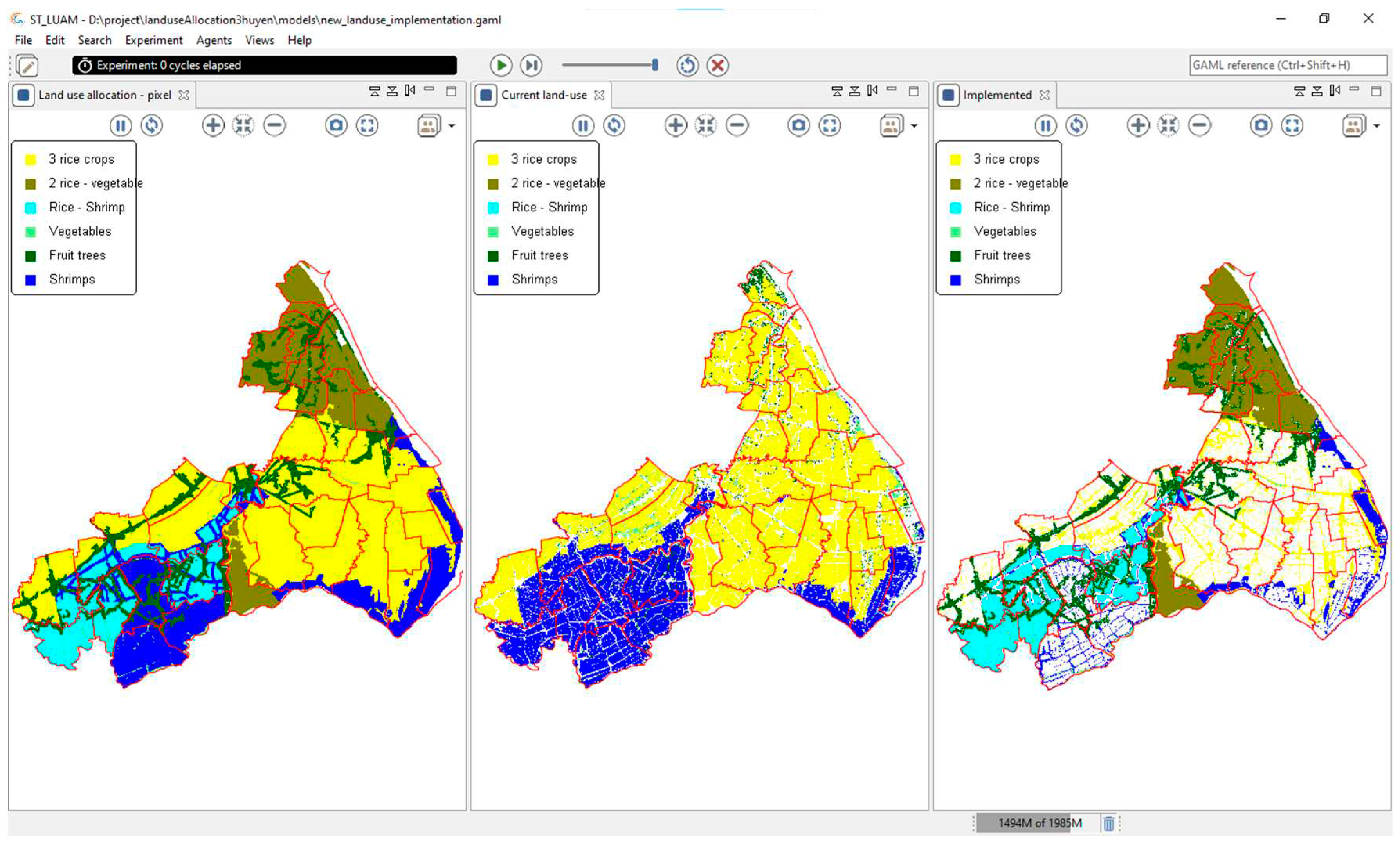
| Factor group | Factors | Source |
|---|---|---|
| Economic | Profit | Santiphop et al. [26]; Liu and Xia [27]; Le et al. [28]; Pham et al. [29] |
| Capital, cost | Le et al. [28]; Sofi et al [30] | |
| Household capital | Bui et al. [31]; | |
| Market demands | Santiphop et al. [26]; Liu and Xia [27] | |
| Social | Labor | Pham et al. [29]; Sofi et al [30] |
| Educational level | Bui et al. [31]; | |
| Neigborhood effect | Le et al. [32]; | |
| Infrastructure (road, canels) | Le et al. [28]; Liu and Xia [27] | |
| Environment | Risk of land-use | Nghi and Hien [33]; Pham et al. [29] |
| Natural factors: soil, water | Most related research |
| LUT | Labor demand | Profits | Environmental benefits | Risk in cultivation | |
| (Day/year/ha) | (million VND/ha) | ||||
| LUT1 | 3 rice crops | 92 | 58.48±4.78 | 3.27±1.18 | 3.20±1.19 |
| LUT2 | 2 rice crops | 78 | 42.42±4.13 | 3.96±1.26 | 2.62±0.68 |
| LUT3 | Rice – Vegetable | 121 | 80.27±4.96 | 4.02±1.00 | 2.51±0.81 |
| LUT4 | Rice – shrimp | 86 | 86.62±7.02 | 4.22±0.87 | 2.96±0.92 |
| LUT5 | Annual crops | 233 | 88.07±5.59 | 3.18±1.18 | 3.36±1.01 |
| LUT6 | Fruit trees | 115 | 184.00±34.83 | 3.42±1.06 | 3.62±0.85 |
| LUT7 | Shrimp | 217 | 277.23±30.16 | 3.16±1.01 | 4.24±1.08 |
| Dictrict | Communes | ||
|---|---|---|---|
| Group 1 | Group 2 | Group 3 | |
| Long Phu | Truong Khanh, Tan Thanh, | Long Phu, Song Phung, Hau Thanh | Long Duc, Chau Khanh, Tân Hung, Phu Huu |
| Tran De | Trung Binh, Lich Hoi Thuong, Thanh Thoi Thuan, Vien Binh | Vien An | Dai An 2, Lieu Tu, Tai Van, Thanh Thoi An |
| My Xuyen | Hoa Tu 1, Hoa Tu 2, Ngoc To, Đại Tâm, TT My Xuyen | Ngoc Dong, Gia Hoa 1, Gia Hoa 2 | Tham Don, Thanh Phu, Thanh Quoi |
| Household’s income per year | NRC qualified (greater than 30 Million VND) |
Not up to NRC standard (20-28 Million VND) | Not up to NRC standard(< 20 Million VND) |
| Poverty rate | NRC qualified ≤ 4% |
NRC qualified (≤ 6%) |
Not up to NRC standard NRC (≤ 23%) |
| Factors | Detailed | Impact on LUTs and allocation orders | Applied |
|---|---|---|---|
| Economic | Profit | LUT7, LUT6, LUT5, LUT4, LUT3, LUT1, LUT2. | Optimization |
| Capacity of investment | LUT7, LUT6, LUT5, LUT4, LUT3, LUT1, LUT2 | Allocation | |
| Social | Labor days | LUT5, LUT7, LUT3, LUT6, LUT1, LUT4, LUT2 | Optimization |
| Road systems | LUT5, LUT6, LUT7, LUT1, LUT4, LUT3, LUT2 | Allocation | |
| Channel systems | LUT5, LUT6, LUT7, LUT4, LUT3, LUT1, LUT2 | Allocation | |
| Neighboring LUT | LUT7, LUT4, LUT1, LUT3, LUT2 | Allocation | |
| Environment | Land suitability | Based on Land suitability order | Optimization |
| Risk of LUT | LUT7, LUT6, LUT1, LUT5, LUT4, LUT3, LUT2 | Optimization | |
| Benefit of environment | LUT2, LUT4, LUT3, LUT1, LUT6, LUT5, LUT7 | Optimization |
| LMU | Soil type |
Acid sulphate occurred |
Salinity (‰) | Persistence of Salinity (months) | Irrigation capability(months) | LUT1 | LUT2 | LUT3 | LUT4 | LUT5 | LUT6 | LUT7 |
| 1 | Anthrosols | No | 2-4 | 5 | 7 | 0.00 | 0.00 | 0.00 | 0.00 | 0.33 | 1.00 | 0.00 |
| 2 | Fluvisols | Active at <50cm | 2-4 | 6 | 6 | 0.00 | 0.67 | 0.67 | 0.00 | 0.33 | 0.00 | 0.00 |
| 3 | Fluvisols | Active at >50cm | 2-4 | 5 | 7 | 0.00 | 0.67 | 0.67 | 0.00 | 0.67 | 0.00 | 0.00 |
| 4 | Anthrosols | No | 4-6 | 5 | 7 | 0.00 | 0.00 | 0.00 | 0.67 | 0.00 | 0.00 | 0.33 |
| 5 | Arenosols | No | 4-6 | 6 | 6 | 0.00 | 0.33 | 0.33 | 0.00 | 0.67 | 0.67 | 0.00 |
| 6 | Fluvisols | Active at <50cm | 4-6 | 5 | 7 | 0.00 | 1.00 | 0.67 | 0.00 | 0.67 | 0.33 | 0.00 |
| 7 | Anthrosols | Active at >50cm | 12-20 | 12 | 0 | 0.00 | 0.00 | 0.00 | 0.33 | 0.00 | 0.00 | 0.67 |
| 8 | Fluvisols | No | 12-20 | 12 | 0 | 0.00 | 0.00 | 0.00 | 0.33 | 0.00 | 0.00 | 0.67 |
| 9 | Fluvisols | Active at <50cm | 12-20 | 12 | 0 | 0.00 | 0.00 | 0.00 | 0.67 | 0.00 | 0.00 | 1.00 |
| 10 | Fluvisols | Active at <50cm | 2-4 | 3 | 9 | 0.00 | 0.67 | 0.33 | 0.00 | 0.33 | 0.67 | 0.00 |
| 11 | Anthrosols | Active at >50cm | 4-6 | 5 | 7 | 0.00 | 0.67 | 0.33 | 0.00 | 0.67 | 0.00 | 0.00 |
| 12 | Fluvisols | No | 6-8 | 3 | 9 | 0.00 | 1.00 | 0.67 | 0.00 | 0.67 | 0.33 | 0.00 |
| 13 | Arenosols | No | 2-4 | 3 | 9 | 0.00 | 0.33 | 0.00 | 0.00 | 1.00 | 0.67 | 0.00 |
| 14 | Fluvisols | Potential at <50cm | 8-12 | 6 | 6 | 0.00 | 0.00 | 0.00 | 1.00 | 0.33 | 0.00 | 0.33 |
| 15 | Anthrosols | Potential at >50cm | 6-8 | 6 | 6 | 0.00 | 0.00 | 0.00 | 0.00 | 0.67 | 1.00 | 0.00 |
| 16 | Anthrosols | Potential at >50cm | 2-4 | 3 | 9 | 0.00 | 0.33 | 0.33 | 0.00 | 0.67 | 1.00 | 0.00 |
| 17 | Fluvisols | Active at <50cm | 8-10 | 6 | 6 | 0.00 | 0.00 | 0.00 | 0.00 | 0.67 | 0.33 | 0.67 |
| 18 | Anthrosols | Potential at >50cm | <2 | 5 | 7 | 0.00 | 0.00 | 0.00 | 0.00 | 1.00 | 0.33 | 0.00 |
| 19 | Anthrosols | Potential at >50cm | <2 | 3 | 9 | 0.00 | 0.00 | 0.00 | 0.00 | 1.00 | 0.33 | 0.00 |
| 20 | Fluvisols | No | 2-4 | 3 | 9 | 1.00 | 0.67 | 0.67 | 0.00 | 0.67 | 1.00 | 0.00 |
| 21 | Fluvisols | No | 2-4 | 6 | 6 | 0.33 | 0.67 | 0.67 | 0.00 | 0.67 | 1.00 | 0.00 |
| 22 | Anthrosols | Potential at >50cm | 2-4 | 5 | 7 | 0.00 | 0.00 | 0.00 | 0.00 | 0.67 | 1.00 | 0.00 |
| 23 | Anthrosols | No | 2-4 | 2 | 10 | 0.00 | 0.00 | 0.00 | 0.00 | 0.67 | 1.00 | 0.00 |
| 24 | Arenosols | No | 8-10 | 5 | 7 | 0.00 | 0.00 | 0.00 | 0.00 | 0.67 | 0.67 | 0.33 |
| 25 | Fluvisols | Active at >50cm | 2-4 | 6 | 6 | 0.67 | 0.67 | 1.00 | 0.00 | 0.67 | 0.00 | 0.00 |
| 26 | Fluvisols | Potential at <50cm | 6-8 | 6 | 6 | 0.00 | 0.67 | 0.67 | 0.00 | 0.33 | 0.33 | 0.00 |
| 27 | Fluvisols | No | 6-8 | 3 | 9 | 0.67 | 0.67 | 0.67 | 0.00 | 0.67 | 0.67 | 0.00 |
| 28 | Anthrosols | Active at >50cm | 2-4 | 3 | 9 | 0.00 | 0.00 | 0.00 | 0.00 | 0.67 | 1.00 | 0.00 |
| LUT | Scenario 1 | Scenario 2 | ||
| Lower bound (ha) | Upper bound (ha) | Lower bound (ha) | Upper bound (ha) | |
| LUT1 | 0 | Unlimited | 0 | Unlimitted |
| LUT2 | 0 | Unlimited | 0 | Unlimitted |
| LUT3 | 0 | 12,768.00 | 0 | 15,436.00 |
| LUT4 | 0 | Unlimitted | 0 | Unlimitted |
| LUT5 | 0 | 2,100.01 | 0 | 2,500.01 |
| LUT6 | 0 | 8,799.00 | 0 | 8,936.00 |
| LUT7 | 0 | 16,697.01 | 0 | 19,236.01 |
Disclaimer/Publisher’s Note: The statements, opinions and data contained in all publications are solely those of the individual author(s) and contributor(s) and not of MDPI and/or the editor(s). MDPI and/or the editor(s) disclaim responsibility for any injury to people or property resulting from any ideas, methods, instructions or products referred to in the content. |
© 2023 by the authors. Licensee MDPI, Basel, Switzerland. This article is an open access article distributed under the terms and conditions of the Creative Commons Attribution (CC BY) license (http://creativecommons.org/licenses/by/4.0/).





